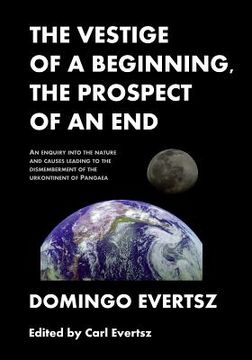The Vestige of a Beginning, The Prospect of an End: An enquiry into the nature and causes leading to the dismemberment of the urkontinent of Pangea (en Inglés)
Reseña del libro "The Vestige of a Beginning, The Prospect of an End: An enquiry into the nature and causes leading to the dismemberment of the urkontinent of Pangea (en Inglés)"
A novel theory explaining the geological make-up of the Earth is presented. It sheds new light on the origin of the Earth/Moon system, the timing of the break-up of Pangaea, and the progression of continental displacement including its implications for life on Earth and Mankind in particular. Where they strongly deviate from mainstream geologic thinking, the critical observations and provocative theories presented are underpinned with cosmological, geological, paleontological, biological, and anthropological arguments bringing to fore unexpected interrelationships. According to the theory presented in this treatise, it was a specific event that took place around 4.5 to 6 billion years ago that set the stage for a dramatic change in the dynamics of the Earth; a change that was initiated about 65 million years ago at the K-Pg boundary between the Mesozoic and the Cenozoic. This shift in dynamics had far reaching implications, and is the key to a radically different pattern of continental displacement, which is driven by transient rotational forces much more dynamic and violent than the forces of convection currents and flight from the poles assumed in the science of geology today. A piece by piece reconstruction of Pangaea is a major task undertaken in this work, lending fresh arguments in favor of Wegener's original concept of a single contiguous super-continent Pangaea; disposing of the need for the hypothetical Gondwanaland and Tethys Sea. "The Vestige of a Beginning, The Prospect of an End" strongly argues against a purely uniformitarian view on geologic and evolutionary phenomena. It puts the Earth, and life and Mankind on it in a new perspective, and promises to be a rewarding book for anyone with an intellectual curiosity and interest into "why" the geography of the Earth is the way it is, and how the dynamics of its continents and oceans shaped life on it. It targets geologists in particular. For scientist in the fields of geology, paleontology, biology, anthropology and astronomy it is the hope that this work will stimulate revisiting existing data and views as well as new research. This treatise provides new views on topics and questions such as: The origin of the single supercontinent Pangaea. How the Earth got its Moon. Why Pangaea broke up and why so late. The displacement pattern of the continents. The dual continental and oceanic nature of the Earth (sial/sima). The relatively young age of the ocean floor. Why the Mid-Atlantic Ocean Ridge has horizontal cracks (transform folds). How mountain chains such as the Alps, the Himalayas, the Andes, the Rockies and the Pyrenees were formed. The origin of the East African Ridge. The origin of the Mediterranean Sea. How island arcs, such as the Sunda, the Aleutian, and the Antillean were formed. The origin of water on Earth. The formation of the Pacific and Atlantic oceans. The location of Great Britain. The distribution of civilizations on the continents. The age of the human species on Earth. How the Americas, Australia and Japan got populated originally. Why gigantism developed in the Mesozoic. Why monthly lunar cycles are so influential on life despite the presence of similarly strong daily tides. Punctuation and evolution. The origin of the mass dying at the end of the Cretaceous, including the extinction of the Dinosaurs.

